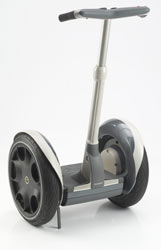
A few years ago, the famed inventor Dean Kamen unveiled a product that he claimed would literally change the world. His invention, the Segway Human Transporter, is a self-balancing, electric-powered transportation device that uses gyroscopes and other mechanical innovations to allow people to travel farther and move quicker -- up to 12.5 mph. Many pundits envisioned the Segway as an enabler of "new urbanism", a way to arrest the pace of sprawl and make cities more livable. Public sector organizations like the U.S. Postal Service piloted the device to deliver the mail and police forces tried it out as a 21st century version of walking the beat.
While the Segway hasn't become quite as ubiquitous as originally touted, it's been described in a recent article as having "an unsought market." The market? People with disabilities!
In some ways, this should come as no surprise. Kamen was a card-carrying social entrepreneur long before he and his team invented the integrated technologies underlying the Segway. After all, he invented the first portable infusion pump capable of delivering drugs (such as insulin) to patients who had previously required round-the-clock monitoring, a phone book-sized dialysis machine, and a six-wheeled robotic "mobility system" for the disabled that can climb stairs, traverse sandy and rocky terrain, and raise its user to eye-level with a standing person.
But if you were a spunky MBA student helping Kamen write the Segway's business plan, you probably wouldn't suggest selling into the "disabled market". Too small. Too distributed. Too diverse. And, apparently, a real beneficiary of innovation's crossover effect.
No comments:
Post a Comment